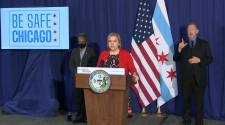The EPA on Thursday unveiled a review of dozens of existing laws it can use to better protect marginalized communities from pollution—a legal “toolbox” to help the agency make good on the Biden administration’s broad environmental justice efforts.
The 191-page legal tools review, which has undergone its first update since 2011, reflects statutory changes both big and small that have been made since the Environmental Protection Agency’s general counsel first published the Obama-era document.
Congress hasn’t passed many far-reaching environmental statutes since the last update, with one big exception: a 2016 bipartisan revamping of the Toxic Substances Control Act giving the EPA more tools to speed up the slow pace of its chemical reviews and strengthening testing authority.
The detailed survey of statutes, “EPA Legal Tools to Advance Environmental Justice,” puts more of a focus on tools that environmental justice advocates argue that the agency haven’t always been wielded, including civil rights laws. The roadmap also reflects EPA Administrator Michael Regan’s 2021 call to all employees to find more ways to integrate environmental equity in their work as the administration pushes to make environmental justice a key platform across agencies.
While the document is primarily written for internal use, it also could assist states authorized to enforce environmental law and regulations as well as environmental justice advocacy groups and industry attorneys.
The updated toolbox showcases “a wide range of legal authorities that EPA can deploy to ensure its programs and activities protect the health and environment of all people, no matter the color of their skin, their zip code, or how much money they have in their pocket,” Regan wrote in the document’s introduction.
Cataloged Authorities
Beyond the chemical law revision, the document provides more detail or expands upon other authorities EPA has to promote environmental justice, from civil rights law to the Clean Air Act. Section 309 of the air pollution statute, for example, gives EPA the authority to review and comment on environmental impact assessments conducted by other federal agencies.
EPA can use that Clean Air Act authority to point out areas where it believes the assessments fall short, such as when agencies offer less-than-vigorous outreach to the public, including marginalized and indigenous communities.
The updated legal review also includes a more detailed discussion of how EPA can use civil rights law that bars discrimination, including in programs and activities awarded funding from the agency.
The statutory authorities outlined in the document—which also include the Safe Drinking Water Act, pesticide and chemical protections, and assisting agencies in their environmental impact reviews under the National Environmental Policy Act—are not the only tools the EPA can wield in pursuing environmental equity, EPA General Counsel Jeffrey Prieto said.
The legal tools instead should be viewed in tandem with other enforcement and other guidance that set out ways to address public health and environmental quality disparities in such communities, Prieto wrote in a separate introduction.
Prieto wrote that he is also pressing his office and various EPA offices of regional counsel “to exercise leadership in identifying options to advance environmental justice and equity, as well as civil rights compliance” to address environmental injustice.


















